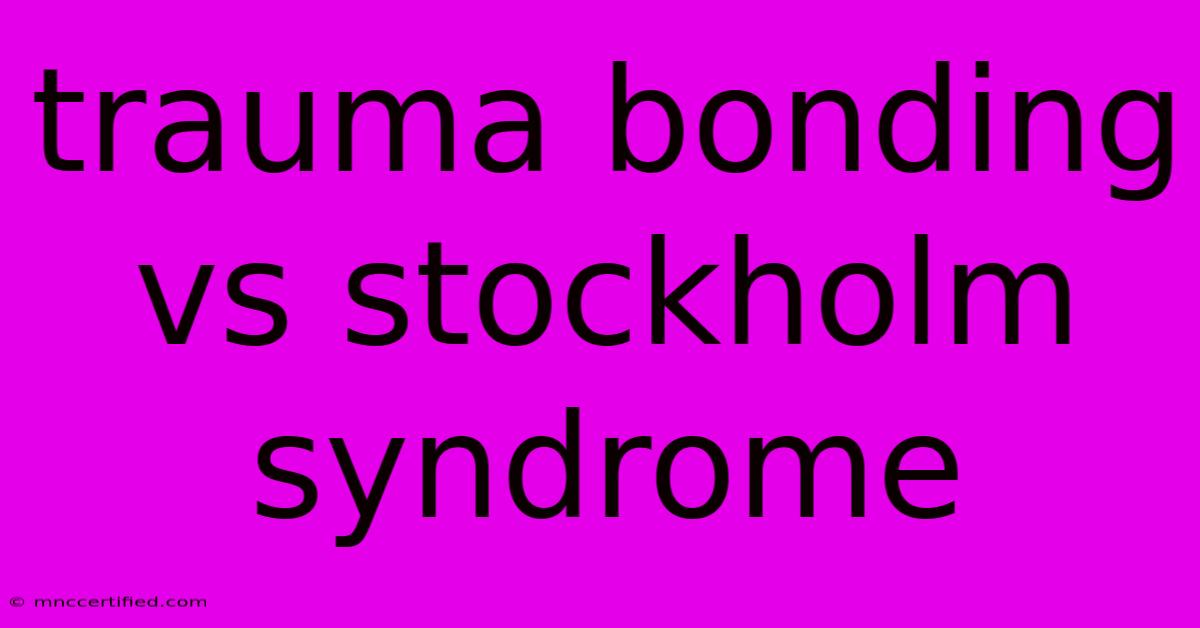Trauma Bonding Vs Stockholm Syndrome

Table of Contents
Trauma Bonding vs. Stockholm Syndrome: Understanding the Complexities of Abuse Dynamics
The terms trauma bonding and Stockholm syndrome are often used interchangeably, but they represent distinct psychological phenomena. While both involve a paradoxical relationship between a victim and their abuser, understanding their nuances is crucial for recognizing and addressing these complex situations.
Understanding Trauma Bonding
Trauma bonding, as the name suggests, is a deep emotional attachment formed by a victim towards their abuser. This bond arises from the cycle of abuse characterized by:
- Intermittent reinforcement: This involves alternating periods of abuse with periods of kindness, love, and affection. The victim becomes addicted to the positive moments, hoping to replicate them and avoid the negative ones.
- Fear and intimidation: The abuser employs threats, physical or emotional violence, and manipulation to control the victim, creating a constant sense of danger and dependence.
- Isolation: The abuser isolates the victim from support systems, reinforcing their dependence and making it harder to break free.
Key characteristics of trauma bonding:
- Emotional dependence: Victims often feel they cannot survive without the abuser, even if they are experiencing abuse.
- Cognitive dissonance: Victims struggle to reconcile the abuser's abusive behavior with their positive qualities, leading to confusion and denial.
- Hope and fear: Victims hold onto hope that the abuser will change while simultaneously fearing the consequences of leaving.
Deciphering Stockholm Syndrome
Stockholm syndrome describes a psychological response where hostages develop a sense of sympathy and empathy for their captors, even after experiencing abuse. This phenomenon typically occurs in captivity situations, where the victim is completely dependent on their captor for survival.
Key aspects of Stockholm syndrome:
- Survival instinct: Victims may see their captors as their only hope for survival and develop a sense of loyalty to protect themselves.
- Cognitive distortion: Victims rationalize the abuser's actions and may even defend them, minimizing the severity of their trauma.
- False sense of control: Victims may believe that cooperating with the abuser will improve their situation, even though it might not be true.
Distinguishing the Differences
While both trauma bonding and Stockholm syndrome involve emotional complexity and paradoxical attachments, their key distinctions lie in:
- Context: Trauma bonding develops in long-term abusive relationships, while Stockholm syndrome typically occurs in short-term captivity situations.
- Attachment: Trauma bonding involves a deep emotional attachment, while Stockholm syndrome focuses on sympathy and empathy.
- Control: Trauma bonding involves a power imbalance and control over the victim, while Stockholm syndrome is more about survival and minimizing threats.
Seeking Help and Recovery
Recognizing the dynamics of trauma bonding and Stockholm syndrome is crucial for breaking free from abusive relationships. Seeking professional help from therapists specializing in trauma and abuse can be immensely beneficial in:
- Understanding the dynamics: Therapists can help victims identify and understand the patterns of abuse.
- Developing coping mechanisms: Victims can learn to manage their emotions and break free from the cycle of abuse.
- Building a support system: Therapists can help victims connect with support groups and resources.
Conclusion
Trauma bonding and Stockholm syndrome are complex psychological responses to abuse and captivity. While they share some similarities, understanding their key differences is essential for recognizing and addressing the complexities of these situations. Victims experiencing these phenomena should seek professional help to navigate the emotional challenges and begin their journey towards healing and recovery.

Thank you for visiting our website wich cover about Trauma Bonding Vs Stockholm Syndrome. We hope the information provided has been useful to you. Feel free to contact us if you have any questions or need further assistance. See you next time and dont miss to bookmark.
Featured Posts
-
What Is A Personal Recognizance Bond
Nov 11, 2024
-
49ers Edge Buccaneers 23 20 Nov 10
Nov 11, 2024
-
Police Probe Mocking Incident At Sheffield Wednesday Match
Nov 11, 2024
-
Celtics Overcome Deficit Beat Bucks 4 Takeaways
Nov 11, 2024
-
Insurance Companies In Topeka Kansas
Nov 11, 2024